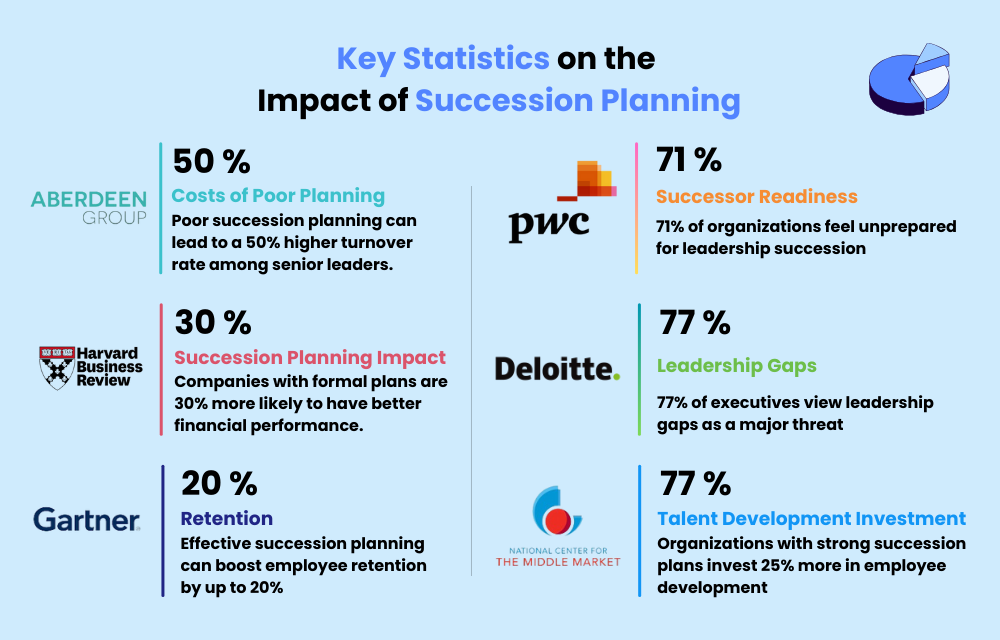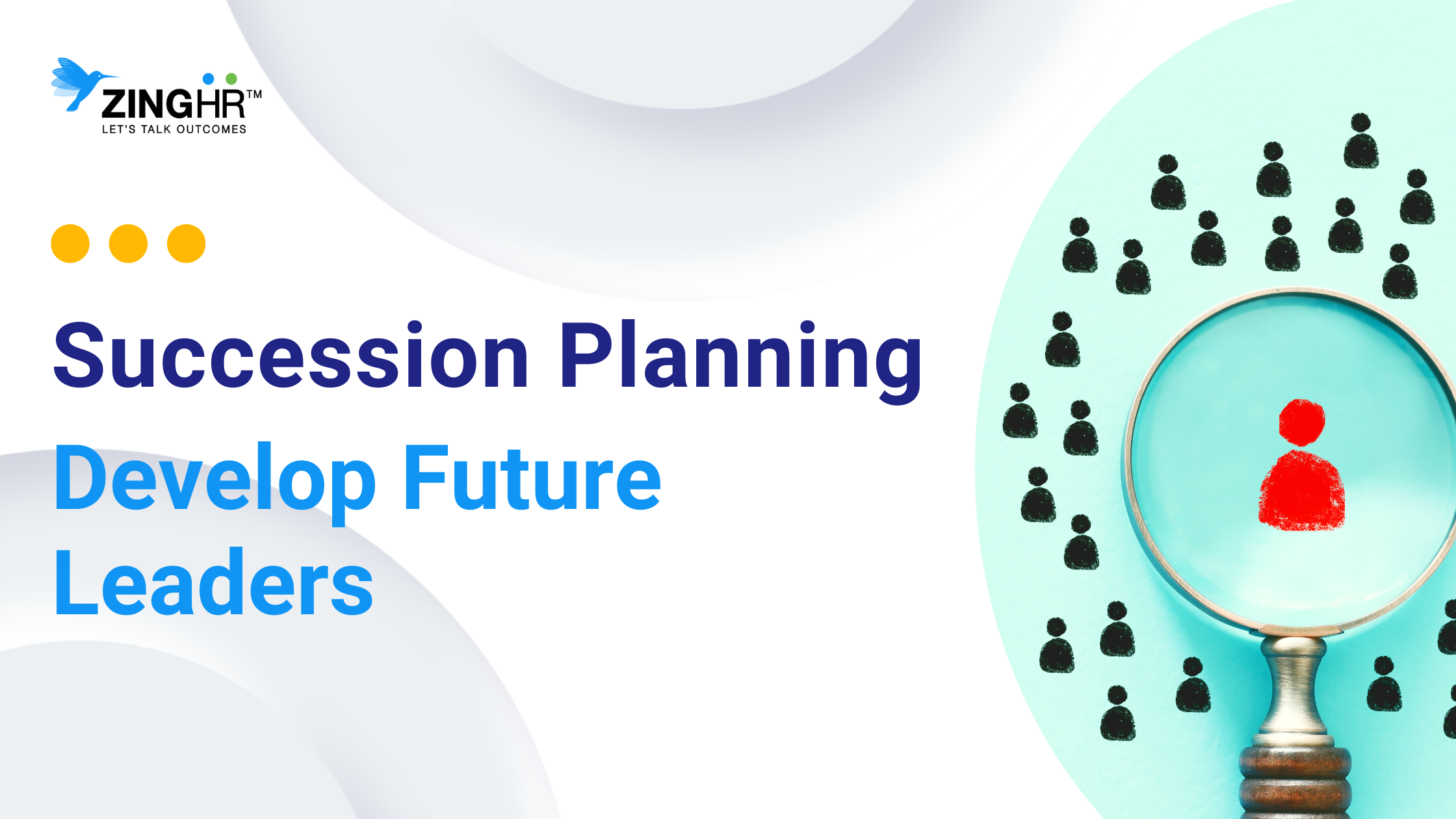Table of Contents
- What is Succession Planning
- Succession Planning Framework
- Why Succession Planning is Important
- Comparing: Existing Employees Vs New Hires
- 8 Proven Strategies for Succession Planning?
- 8 Steps in the Succession Planning Process
- Why You Need ZingHR For Your Succession Planning
- Succession Planning Examples
- Conclusion
Succession planning is one of the most crucial things in safeguarding an organization’s future. It also plays a critical role in ensuring a company’s longevity by analyzing and anticipating future leadership requirements.
This process involves finding and developing internal candidates to fill key leadership positions in the future. An effective succession plan secures a company, improves employee morale and also boosts employee retention.
ZingHR simplifies this process with advanced HR solutions like talent assessment tools, personalized development programs, and digital leadership platforms. Additionally, zingHR offers solutions to help businesses identify and develop employees with the potential to lead the company.
In this blog, we will highlight the importance, steps, and meaning of succession planning and help you with specific methods of effectively implementing succession strategies.
What is Succession Planning
Succession Planning is a process to identify and develop future leaders to fill vacant job positions in an organization. An effective succession plan prepares for potential changes in the company, especially in leadership roles, by anticipating future needs and fostering employee development.
At ZingHR, we understand that succession planning in HRM is much more than just filling up leadership roles, it’s about identifying and grooming the right people to lead the organization in the future. Hence, to help businesses in this critical journey, we offer a range of products and services that are designed to help organizations implement effective succession plans.
So let’s dive right in to understand the ins and outs of effective succession planning.
Succession Planning Framework
A succession planning framework is a structured, strategic approach to identifying and preparing future leaders inside the organization. This framework analyses current leadership roles, forecasts future needs, and develops talent pipelines to ensure a seamless transition when key positions become vacant.
- Identify which positions are crucial for organizational success. Focus on roles that significantly impact business outcomes.
- Evaluate the skills, experience and potential of current employees to identify people who can fill key roles.
- Create personalized development plans and involve training, mentoring, job rotations, and leadership workshops to prepare candidates.
- Review progress regularly and adjust development plans or succession candidates as necessary.

Why Succession Planning is Important
Unlike most corporate buzzwords, succession planning means something very important in the business world. It plays a significant role in an organization’s operations and its future. Let’s take a look at why organizations need to make succession planning a priority.
1. Develop Tomorrow’s Talent Now
Succession planning is the future of the organization, it’s about finding and grooming the next generation of leaders. This is a critical process to safeguard the future of the organization. To do that, you have to identify high-potential employees and give them the opportunities to learn and grow today. Preparing your talent for tomorrow will ensure that the organization isn’t affected by change and also ensure that the future is in capable hands.
This process helps bridge the gap between today’s leaders and tomorrow’s, aligning everyone with the company’s long-term vision, ensuring clarity and future-proofing.
Tip: Focuses on leadership skills, technical expertise, and soft skills. Use mentorship and coaching to guide key employees.
2. Unlock Cross-Functional Collaboration
An effective succession plan generally goes above and beyond individual roles, it encourages cross-functional learning for the employees, since it’s critical for leaders to know how to run the business. Organizations can groom better leaders by having them work in multiple areas of the business so that they become versatile enough to manage and mitigate various challenges.
This also helps build a culture of collaboration within the organization and helps the employees see and understand the bigger picture.
Tip: Encourage employees to collaborate on cross-departmental initiatives and job rotations. This helps employees develop a flexible skill set, encourages cooperation, and gives them a deeper understanding of the business, which improves their capacity to lead in a variety of areas.
3. Outpace Competition with Strategic Talent Redeployment
Succession planning helps an organization develop the skills of its employees in more than one department. This helps organizations use their employees in multiple ways effectively, by enabling them to place the right people in the right roles at the right time. By doing this, organizations can quickly adapt to the dynamic nature of the market and take advantage of the opportunities that arise due to the change in the industry before their competitors.
Tip: analyze talent strengths and match them to business requirements. Use HR analytics to detect skill shortages and strategically deploy individuals to areas where their abilities are most valuable, allowing the firm to stay ahead of the competition.
4. Unlock Opportunities and Hidden Talent for an Inclusive Workforce
A robust succession plan helps you find hidden talents within your workforce as it promotes an inclusive and diverse leadership pipeline for the future. By focusing and investing in developing internal talent rather than hiring external people, it gives the employees an added incentive to learn, grow, and perform to the best of their abilities. This approach helps the organization build a rich talent pool while developing a culture of inclusivity wherein everyone feels like they have the opportunity to grow if they want to, and they work towards it.
Tip: Workforce Create a various talent development program that identifies and supports individuals from all backgrounds. To develop a diverse and inclusive leadership pipeline, use fair evaluation techniques and give equitable growth chances.
5. Preserving Organizational Knowledge
Generally, when experienced personnel such as people in leadership positions leave an organization they take away valuable knowledge, insights, and know-how with them. These things are quite difficult to replace and that’s where succession planning comes in handy as it ensures that such knowledge is preserved and passed on to the successors. These potential successors get opportunities to learn from the existing leaders, helping them get into the minds of the leaders who have led the organization for years.
Tip: Create knowledge-sharing forums where leaders can record their insights, processes, and best practices. You can consider webinars, job shadowing and mentorship programs to transfer knowledge effectively.
6. Enhancing Employee Morale and Encouraging Growth
Succession planning plays a vital role in enhancing employee morale by clearly outlining growth opportunities for them. When employees see that the organization is investing time, money, and resources for their growth, they feel valued, and this drives them to succeed and repay the faith shown in them by the organization. Such things generally strengthen loyalty and encourage employees to perform well with hunger and dedication. They know that if they perform well, the company will reward them with growth opportunities.
By focusing on internal growth, succession planning promotes a motivating work culture wherein employees are hungry to succeed and contribute to the organization’s growth.
Tip: Increase employee motivation by communicating succession planning options. Make it apparent that the business invests in employee development offers development opportunities, and encourages people to actively participate in their own growth.
7. Opportunity for Existing Employees to Grow
No one wants to work in an organization where they don’t see a clear path to grow and advance their career. People don’t want to be stuck doing the same job for years, everyone wants to climb up the corporate ladder. Employees feel motivated when they work in an organization that gives them opportunities to grow in the organization.
A clear and robust succession plan generally showcases the organization’s commitment not only to its own future but also to its employee’s futures. The company can showcase this by fostering a culture of growth and development, this also plays a significant role in boosting employee morale while further strengthening their loyalty towards the company.
Tip: Provide development programs that suit for individual requirements, such as leadership training, workshops, and cross-functional projects. Career pathways should be reviewed and updated regularly to enable employees to see their possibilities for advancement.
Comparing: Existing Employees Vs New Hires
| Aspect | Existing Employees | New Hires |
|---|---|---|
| Experience with Company Culture | Familiar with company values and processes. | Requires time to adapt and understand the culture. |
| Institutional Knowledge | Deep understanding of company history, projects, and relationships. | Limited knowledge of the company’s history and operations. |
| Development Opportunities | Clear career paths and growth opportunities within the organization. | Requires onboarding and tailored development programs. |
| Cost of Transition | Typically lower due to familiarity with the company. | Higher due to training and longer ramp-up time. |
| Risk | Potential for internal politics or stagnation if not managed well. | Higher risk of turnover if expectations are not met. |
| Innovation | May be less likely to bring new ideas. | Fresh perspectives and innovative ideas. |
| Retention | Higher retention rates with clear advancement opportunities. | Higher turnover risk if integration is not successful. |
| Integration Time | Shorter, as employees are already familiar with the company. | Longer, as new hires need to learn and adapt to the environment. |
8. Help to Save Recruitment Costs
When it comes to leadership positions, you can’t take risks that might cost the company. And that’s exactly what it is, to hire someone who doesn’t know the ins and outs of your business. Hiring someone like that can cost the company much more the time and money that they invest in finding that person. This makes it critical for organizations to have a robust succession plan.
A well-developed succession plan significantly reduces if not completely negates the need to hire external talent as it focuses on developing internal talent and preparing them for future leadership opportunities within the organization.
Tip: Create a talent pipeline inside your organization by recognizing and developing high-potential individuals early on. This decreases reliance on external recruiting, saving money and time while fostering a culture of internal mobility.
8 Proven Strategies for Succession Planning
Developing an effective and robust succession plan needs a strategic approach by both the HR department as well as the current leaders. Let’s dive deep into it.
1. Identify the Critical Job Positions
Before making a plan you need to know what the plan is for. And for that, it’s important to first analyze and identify the critical roles within the company. Once you’ve identified these critical roles, you can start preparing potential successors who can take up those roles in the future. This foresight allows the organization to have a seamless transition that doesn’t affect its operations due to changes in the leadership roles.
2. Select Current Employees for Potential Successors
After the first step, wherein you’ve identified the positions that play a significant role in the functioning of your organization. You need to identify employees who have the potential to succeed in those critical designations.
For that, you’ll have to evaluate your current employees, have conversations with them, understand their point of view on the company, ask them where they see themselves in the future, and find out the kind of leader they want or aspire to be. These conversations will not only help you evaluate your employee as a professional but also as a person, which is very important as leadership roles are critical and quite demanding, and you need to be good beyond your actual job to be a leader.
Having said that, the employees need to be great at what their role demands, so make use of performance reviews and feedback as well. Post this process, you can make a shortlist of people who seem to be the right fit to take on leadership roles in the future.
3. Hackathons for Problem-Solving
Problem-solving is one of the most vital skills that you need in a leadership role. Therefore, having this skill is a must for any employee who aspires to be a future leader within the organization. That’s where hackathons come into play, they are designed to boost the problem-solving skills of employees. These hackathons generally put teams together and ask them to solve problems through collaboration.
Hackathons are a great way to identify potential leaders as hackathons help employees showcase critical skills like problem-solving, collaboration, teamwork, creativity, and calmness under pressure. Employees are generally tasked with problems that leaders face in real life, such problems demand a high-energy and highly collaborative environment where different minds have to work together to implement solutions quickly.
These events generally involve potential future leaders, and they give the current leaders a chance to observe and evaluate these employees in a dynamic setting. Consequently, getting insights into their mind, and understanding their potential to lead and handle critical situations.
4. Assess Talent Pool
Once you’ve identified the key roles and the potential successors for those roles, you need to assess the employees to understand your talent pool. Your assessment process should involve performance evaluation, identification of skill gaps, and highlighting areas for improvement. These assessments help you understand which employees are ready to take the next step and which need more grooming and training. Subsequently, helping you fill the right position at the right time and most importantly with the right people and making your succession planning process seamless and streamlined.
5. Create Development Plans
Creating a personalized development plan for your employees is a crucial part of a robust succession planning process. This is critical in preparing and grooming them for future leadership roles. The purpose of creating development plans is to level up their skills, help them gain relevant experience, identify and fill any gaps, and much more. By providing a clear growth and development path you can ensure that the future leaders of your organization are well-equipped to take on the leadership roles seamlessly.
6. Offer Mentorship and Coaching
As we all know, theory can’t be the only way to develop as an individual, you also need practical lessons from people who have been there and done that. That’s right, mentorship is a very critical part of any employee development program as it connects the junior employees with the senior employees. This allows knowledge transfer within the organization and the future leaders can learn how a leader operates by working with the current leaders. Mentors provide valuable feedback, offer real-world experience, etc. things that go beyond formal training. Also, the one-on-one mentorship support accelerates the growth of the employees who will potentially lead the organization in the future.
7. Create Clear Career Paths
Organisations need to create clear career planning within the organization to keep the employees motivated and aligned with the organization’s long-term vision. A clear progression plan shows the people what they need to do to grow and advance within the organization. This clarity motivates them to put their effort in the right places to reach higher positions, it also helps organizations retain top talent as it shows a clear motive of helping employees grow rather than stagnate their careers. A clear path boosts employee morale, encourages skill development, and builds loyalty as the employee can see a future for them in the organization.
8. Show Care About Employee Career Development
Career development is strategic workforce planning that helps employees improve skills, knowledge, and experience to excel in their careers. This not only improves employee engagement but also boosts motivation. When employees find value in their professional goals, they are more happier to stay with the organization. For employers, investing is similarly beneficial. Additionally, focusing on career development helps to create a strong internal talent pipeline for future leadership demands.
Here are the reasons why should care about career development
- Reduce Employee Attrition Rate
- Increase Job Satisfaction
- Foster a Learning Culture
- Adapt to Changing Market Needs
- Encourage Employee Loyalty and Trust
- Improve Performance and Productivity
- Align Employee Goals Company Objectives
8 Steps in the Succession Planning Process
Succession planning is not as easy as it sounds, but you can make the process simple and streamlined with ZingHR. Just click on the link and take a look at how ZingHR simplifies the succession planning process for you.
Step 1: Shortlist Potential Critical Positions
Succession planning begins with identifying the critical roles in your organization. Roles that have a direct impact on your organization’s functioning. These are generally leadership roles.
Step 2: Define Assessment for a Critical Position
Develop specific criteria and evaluation techniques to assess employees for potential leadership or critical roles in the organization. This assessment is quite important as it decides whether the organization has employees who can properly carry out the duties that a leadership role demands. The assessment generally consists of skill tests, interviews, and performance evaluations.
Step 3. Identify Ability, Skills, Knowledge
Once you’ve assessed the candidates, you need to identify their skills, abilities, and knowledge. This will help you align them with the suitable positions that they can potentially take over in the future. This involves identifying both technical as well as soft skills needed to succeed in leadership positions. Identification of these things will help you tailor your succession plan effectively and efficiently.
Here’s how You can Identify It
This table format breaks down each element of the skills, abilities, and knowledge with examples and techniques to assess.
| Category | Definition | Examples | Assessment Methods |
|---|---|---|---|
| Skills | A special technique or specific learned capabilities that enable a person to perform a task. |
– Technical skills – Communication – Leadership – Time management |
– Skill assessments – Job simulations – Training completion – Aptitude tests |
| Abilities | The power to do something, focusing on innate traits and developed competencies. |
– Critical thinking – Analysis and problem-solving – Creativity |
– Problem-solving tasks – Cognitive tests |
| Knowledge | Information and understanding gained through education, experience, or training. |
– Domain expertise – Product knowledge – Legal regulations – Awareness |
– Knowledge tests – Certifications – Performance reviews |
Step 4. Develop Successors
Post your identification of potential successors for critical roles in your organization, it’s time to focus on grooming and developing them. You need to create a personalized development plan for each individual as everyone will have different skill sets and different requirements. This plan generally includes training, cross-functional projects, mentorship and coaching, leadership workshops, feedback sessions, and much more. The goal is to equip the potential leaders of your organization with all the things they need to be successful.
Step 5. Provide Leadership Training
Since the people you’ve identified as potential future leaders of the organization, it is essential to train them to be leaders. This process generally focuses on developing both technical and soft skills necessary to effectively carry out the duties of the given role. You can include things like strategic thinking, problem-solving, decision-making, emotional intelligence, conflict resolution, team management, etc. These skills are crucial to have as leaders. This training will develop your employees and make them ready to handle the challenges that they may face once they fill the leadership roles in the organization.
Step 6. Implement a Mentorship Program
A mentorship program plays a vital role in developing an employee. It pairs experienced leaders with their potential successors within the organization. This relationship is quite crucial to ensure a smooth transition period for the organization. Successors can learn a lot from the experience of the current leaders, gaining insights and knowledge about the business and the role. This step accelerates the development of successors while building a culture of developing learners and leaders in the organization.
Step 7. Evaluate Candidate /Job Handover
Before a successor takes up a critical leadership role in the organization, it’s important to evaluate their readiness. This includes analyzing their development in the aforementioned training and programs. You can ensure their readiness by having them assume the role for a trial period wherein they can work with the current leader side-by-side and gradually take on more responsibilities as time passes by. This practical experience will allow the employee to get a grip on the job and it will ensure that the organization isn’t disrupted by this change.
Step 8: Review and Revise the Succession Plan Regularly
It’s important to review your succession plan at regular intervals. Since the business world is constantly evolving, you’ll need to adapt to the changes and make sure that your plans don’t turn your organization into a dinosaur. You can see the overview of your succession plan on the portal, this will help you analyze the state of your plan which is crucial in making any improvements to the plan if necessary.
Why You Need ZingHR For Your Succession Planning
ZingHR offers a wide range of products and services that make succession planning easier, efficient, streamlined, and robust. ZingHR is here to make your lives easier and help you in your succession planning efforts with tools that are designed to help you make the optimal succession plan for your organization. Let’s take a look at some of the reasons that make ZingHR a must-have for your succession planning process.
- Ensure Business Continuity: ZingHR’s solutions ensure smooth leadership transitions within the organization. This helps the organization continue its business operation with a much-lowered risk of disruptions.
- Future-Proof Your Workforce: With ZingHR’s tools, you get access to data and insights that equip your team for upcoming challenges. These tools help you analyze skill gaps as well, subsequently helping you plan for the future.
- Reduce Costs and Redeploy Talent: ZingHR’s tools are designed to help you reduce your recruitment and retention costs. This is possible as promotion from within the organization eliminates the need for external recruitment.
- Boost Employee Engagement: ZingHR’s development programs are great for your employees as they improve engagement by providing growth and development opportunities within the company.
- Turn Skills into a Competitive Advantage: Our tools give you access to various data points that help you evaluate your employee’s skills as well as get the necessary insights required for their upskilling.
- Develop Tomorrow’s Talent Now: Our targeted development programs are designed and developed to equip your potential successors with everything they need to tackle challenges and succeed.
Succession Planning Examples
Real-World Examples of Effective Succession Planning
Example 1: GE’s Leadership Development
General Electric (GE) has a strong leadership development program. The objective of the program is to identify high-potential individuals early on. Once identified, these individuals are provided training and development programs to help them grow. By doing this, GE ensures that they’re always ready for the future as they have a pipeline of potential leaders ready to step up when the time comes.
Example 2: PepsiCo’s Talent Sustainability
PepsiCo approaches succession planning by building a diverse and broad talent pool. Also, they identify and develop talented people with different skills and specialities, people who come from different backgrounds. This ensures that the company has leaders who always bring in new and distinct ideas and perspectives, helping the company grow through innovation.
Conclusion
Succession planning is one of the most important processes for businesses that seek to safeguard their future and maintain organizational stability and growth. It helps organizations prepare for future transitions when it comes to leadership within the organization. By implementing effective succession planning strategies, an organization can minimize any possible disruption to business operations.
Investing in effective succession planning plays a critical role in things such as saving resources by negating the need for external hiring, preserving institutional knowledge, boosting employee morale, and much more. In short, These are the benefits of investing in your current employees creating growth within the organization. It also is a huge plus point for the organization as they have a pipeline of potential leaders at their disposal, people who know their business in and out, ensuring a smooth and seamless transition.
ZingHR’s comprehensive HCM Software is designed to streamline your succession planning. The tools help you identify potential successors, create a growth path tailored specifically for them, and develop programs that groom them to take over leadership roles in the future.
ZingHR helps your organization with all the vital resources that are needed to make a robust and effective succession plan.
In conclusion, Strategies for Succession Planning is a crucial practice for an organization aiming to scale and grow consistently. To build a stable, resilient, and future-ready workforce, organizations need to prioritize succession planning, and they can easily do so by utilizing tools and services like the ones offered by ZingHR.




